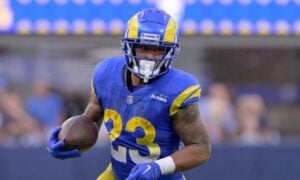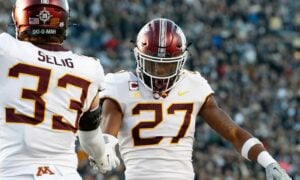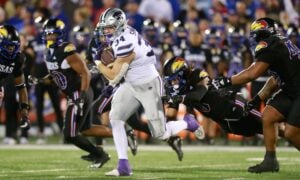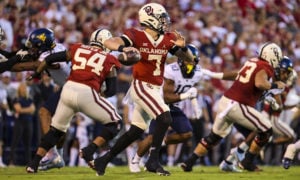Dynasty GAAP Memo: 2024 Free Agent Wide Receivers and the Christian Kirk Model

If you’ve read my work before, you know I write in the form of “accounting memos”. For anyone who has not been exposed, the format is very standard. Each memo will start with the “purpose”. Next, it will outline the applicable “guidance” or accounting literature utilized and supply background. Last will be the analysis and conclusion. The goal is to state the issue and quickly address it. My write-ups will follow this same logic. To summarize, welcome to “Good at Analyzing Players” or “GAAP,” a play on “Generally Accepted Accounting Principles.”
Purpose
To evaluate free pending 2024 free agent wide receivers utilizing the ‘Christian Kirk Model’.
Background
I wrote about the Christian Kirk model in my last memo and applied the concept to running backs. If you read that, you can skip to the analysis below. If not, continue reading and please check out the RB memo as well!
During the 2021 offseason, Christian Kirk was awarded one of the most lucrative WR contracts in NFL history. After being selected in the second round of the 2018 NFL Draft, Kirk had just come off his rookie contract with the Cardinals and had amassed 77 catches for 982 yards and 5 TDs. While this certainly merited a raise from his rookie contract, the amount of the contract was shocking and left a lot of people around the NFL scratching their heads. At the time of signing, Kirk’s 4 year and $72M contract (with incentives up to $84M) put Kirk as the third highest-paid WR in the NFL. Not back for a receiver who had never eclipsed 1,000 yards. This contract had impacts across the NFL and is often credited for the explosion we have seen recently with WR contracts.
Through two years into his contract, Kirk has actually lived up to his contract. In 2022, he finished as WR11 in PPR with 84 catches, 1,108 yards and 8 TDs. Then in 2023, he was again on pace to finish as a top 24 PPR WR with over 1,100 yards before his injury in week 13. As we approach free agency, Christian Kirk is a good reminder. Often teams in free agency swing and miss. However, if you follow the funds (or contracts), teams will tell you what they are trying to do and you can potentially identify buying opportunities. Meaning, if consensus is mocking a team overpaying a player, it could present a buying opportunity.
This week’s memo will dive into this theory, which I have coined the “Christian Kirk Model”, and project it upon the free agent wide receiver class.
Resources:
- Sleeper: Great interface for looking up historical statistics
- DLF Dynasty Rankings: Best dynasty rankings in the industry
- DLF Average Draft Position (“ADP”) Data: Best resource to gauge current player value. Based on real dynasty startups.
Analysis
In accounting, some financial assets are difficult to value. Businesses often must establish fair values for the assets that they carry on their books. Due to this, the Financial Accounting Standards Board (governing body of accounting) has derived “asset levels.” The intent of these levels is to define the requirements for fair value measurements. Each level has different requirements. See each level defined below discussed below:
- Level 1 Assets – liquid financial assets and liabilities, such as stocks or bonds, that experience regular market pricing. For instance, stock prices are readily available via the stock market.
- Level 2 Assets – financial assets and liabilities that do not have regular market pricing. Level 2 assets must be valued using market data obtained from external, independent sources. The data used can include quoted prices for similar assets and liabilities in active markets, prices for identical or similar assets and liabilities in inactive markets, or models with observable inputs. These include default rates, interest rates, and yield curves.
- Level 3 Assets – financial assets and liabilities considered to be the most illiquid and hardest to value. They are not traded frequently, so it is difficult to give them a reliable and accurate market price. Examples of Level 3 assets include mortgage-backed securities (MBS), private equity shares, complex derivatives, foreign stocks, and distressed debt.
In dynasty, a player’s value is predicated on asset types from all three levels. Elements like past production and age would be considered ‘level 1’ assets. These elements are readily available and observable. We also leverage rankings and trade calculators to quantify a player’s value. These come from industry sites like DLF and would be considered a ‘level 2’ asset. Finally. level three assets are what introduce the “Christian Kirk Model” mentioned above.
Spotrac is a great website that I utilize all the time to look up contract details. However, for select players, the site derives a fair market value for pending free agents. This mode is based upon the player’s historical production, age, and other inputs (Games Played %, Receiving Yards, Receiving Touchdowns, Receptions, etc.). These factors are input into a linear regression model along with statistical comparisons to derive a fair market value for the player. Pretty neat? This is a great example of how to value a “level 3” asset.
As mentioned before, this memo will evaluate pending free agent wide receivers utilizing this concept.
Disclaimer: Four months ago, this list was a lot more interesting. I excluded Michael Pittman and Tee Higgins as they were franchised tagged. However, I would continue to keep an eye on them as both have not signed yet and have been included in trade rumors. I would also include Diontae Johnson in that group as his name keeps coming up in trade talks.
Level 1 Asset: Age
The table below takes the sample population, calculates the average, and then compares the player’s age to the calculated average and ranks them. For instance, Tyler Boyd is 29.2, which is 1.3 years older than the 27.9-year-old average. This would rank him as the seventh oldest in the population considered.

Level 2 Asset: DLF WR Rank and Trade Calculator Value
Similar to the table above, this table calculates the average DLF WR rank as well as the DLF Trade calculator value. This is then compared against the average and ranked.

Observation: The biggest surprise here is how far ahead the community ranks a 29-year-old Calvin Ridley over the rest of the class. I get he is by far the most proven talent and the only to finish as a top 24 receiver in 2023, but that was surprising to me with how much we often tend to over-value youth. I also thought Darnell Mooney’s 17.7 trade value was an error when I initially saw it (I double checked). Let us not forget that he has a 1,000-yard season on his resume and what the Bears offense has been the last couple of seasons.
Level 3 Asset: Forecasted Spotrac Average Salary and Projected Contract Length
Lastly, this table considers the projected average salary for each player as well as the contract length and compares it to the average and ranks accordingly. The thought here is that a bigger salary and longer contract could be indicative of a team’s confidence in the player, similar to Christian Kirk in 2021.

Observation: I am a legacy believer of Marquise “Hollywood” Brown. You can see a past memo I wrote about him here. However, it was good to see that Spotrac believes that the NFL will value him with the highest average salary and contract length projection. At some point, we must stop making excuses for him, but I still think the talent is there. If he lands in an ideal landing spot, he could be a WR2/WR3 the entirety of his second contract (4 years). That is valuable in dynasty and worth chasing.
Conclusion
The table below aggregates the rankings from the level 1, level 2, and level 3 asset rankings above to derive the completed model. As a reminder, these are ranks so, lower is better.

I summarized my thoughts below:
- Marquise Brown – As I mentioned above, I’m still a believer and enjoyed seeing him as #1 on this list. If I could get Hollywood for a mid to late second, I would. Just two years ago he was traded for a first round NFL draft pick. Since then, he had his seasons derailed by injury (to himself and Kyler Murray). It is worth noting that I have not seen a single buzz tweet about him leading up to free agency and teams targeting him. Maybe I am wrong, but I’ve spent late 2nds on rookies that never made the field.
- Calvin Ridley – Admittedly, I am not a “Ridley believe it or not” guy (see what I did there?). However, I have seen a lot of hype surrounding him and I think the demand for his services will be real. If it were not for his age, he would be by far #1 in this model. Again, a great buy for a second-round rookie pick that can be started as your WR3/WR4 weekly with confidence on a championship roster.
- Gabe Davis – Not only is Davis still 24, he also is projected $13M per year over 4 years. That is something. Ironically, one of the best comparisons is Christian Kirk’s 4 year and $72M contract. The community has swung too far on him. I recently sent two late thirds for him in a league and liked the upside. Here is to hoping he lands in a good spot!
- Darnell Mooney – On one hand, he is young, has a 1,000-yard season on his resume, and is projected to sign a stable 4-year contract. On the other hand, he has been a ghost since 2021 and the projected contract is similar to players like Tim Patrick (27), Hunter Renfrow (26), and Allen Robinson’s (28) contracts. None of which aged well from a fantasy football prospective. I would throw a late 3rd or 4th at him. If you are an owner, I would hold until after he signs and has camp hype to get out. Might be a player you can buy low on now and sell in six months for a small return.
- Odell Beckham – There is a timeline in the multiverse where he returns to be fantasy football viable. Do I think he will? No. Do I think most owners will give him away for a bag of chips? Yes. Throw your late round 2023 rookie that did not do anything in year 1 at him. Why not? He projects to be the fourth highest on the list in average salary.
“Beckham earned a total of $16M in 2023 from the Ravens. Meaning, he made $457K per catch.”
- Dynasty GAAP Memo: Diontae Johnson - March 29, 2024
- Dynasty GAAP Memo: 2024 Free Agent Wide Receivers and the Christian Kirk Model - March 11, 2024
- Dynasty GAAP Memo: 2024 Free Agent Running Backs and the Christian Kirk Model - March 1, 2024


































































